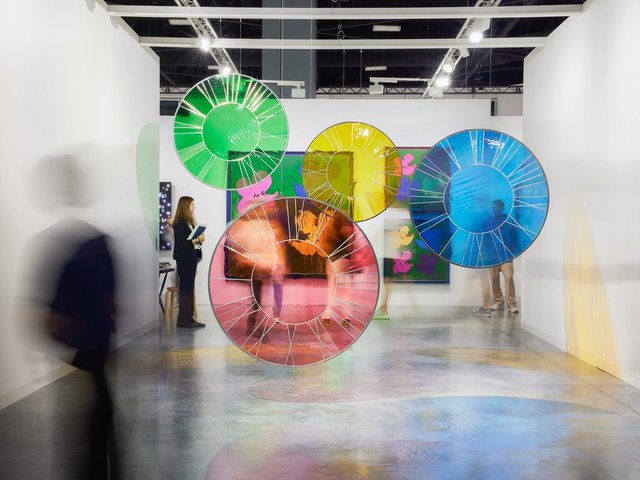Art Basel in Miami Beach remains the crown jewel of Miami Art Week. But do the benefits of exhibiting here outweigh the premium cost it demands after the rockiest year in recent art market memory?
No group of exhibitors has more at stake than the first-timers. The fair’s 2023 edition features 25 dealers making their debut: almost 10% of the 277 galleries on the show floor. Across sections, Art Basel in Miami Beach rookies surveyed by The Art Newspaper agreed that the money, blood and sweat required to get here is paying off.
Jeffrey Lee, a partner at Ryan Lee Gallery in New York, has found attendance to be “much more international” than at other fairs—highlighted by early interest from collectors based in Korea and Europe. “It’s so important to do this fair,” Lee says, as it has already proven that “despite all the [negative] news about the market, it’s still a great time for great art”.
Ryan Lee, which typically participates in four to six fairs per year, is pulling double duty in its maiden voyage, showing paintings and drawings that the late New York-based artist Vivian Browne made between 1971 and 1974 in the Survey section and a sculptural installation by Masako Miki in the Meridians section. By early Wednesday afternoon, the gallery had sold one painting (priced between $100,000 and $265,000) and two drawings ($19,000 each) by Browne, as well as registering “serious interest” in Miki’s installation.
Another allure is the fair’s propensity to platform practices that are exciting and innovative but not necessarily simple. “We’re showing challenging works. It’s not hot, wet paintings,” says Sara Maria Salamone, the co-founder and director of Mrs. gallery in New York.
Mrs., which normally participates in four to five fairs per year, won a spot in the Positions section of Art Basel in Miami Beach on its second try—and only after being waitlisted. It is spotlighting Nickola Pottinger, the Jamaica-born, Brooklyn-raised artist whose work combines found furniture, mementos and paper pulp upcycled from family documents, then moulded using casts of her own body to form “duppies”: protector spirits from the Caribbean tradition.
“This section was the most ideal for us,” Salamone says of Positions. “We’re a newer gallery, we don’t have a budget that’s blue chip-sized and we thought Nickola deserved a focused presentation.” The gallery placed Duppy Batty (2023) for $16,000 by midday on Thursday, with significant curatorial interest in other pieces. Sculptures on the stand range from $12,000 to $24,000.
Other first-time exhibitors agree that Art Basel in Miami Beach remains an unmissable destination for US institutions. “Curators across America make this fair a priority,” says Katey Acquaro, the director of Silverlens Galleries, based in Manila and New York. Its stand, in the Nova section for works created in the past three years, is the first solo presentation in the US by the 70-year-old Philippines-based artist Norberto Roldan.
Roldan’s presentation consists of banners and shelved wall assemblages that blend religious and revolutionary iconography to explore the tensions between hard and soft power. Each piece is on offer for $25,000, a price still accessible to collectors based in the Philippines.
“Hopefully, it’s a two-way portal,” Acquaro says of the cultural and commercial potential of the fair. She adds that the expo is an exceptional fit for both Silverlens and Roldan due to the Philippines’s existence at the cross-section of Latin America and Asia: “We feel exceptionally welcome in our first time here, which is not usually the case at some other fairs.”
The responsiveness of the fair leadership was also noted; multiple dealers praised Art Basel personnel for their willingness to engage and problem-solve.
Acquaro sums it up best: “It’s a tiring fair, but it’s worth it.”



